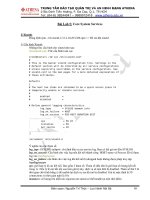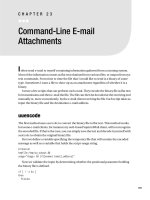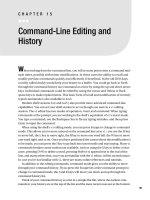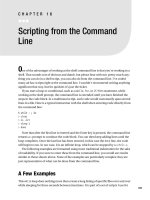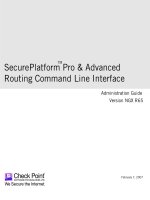The linux command line
Bạn đang xem bản rút gọn của tài liệu. Xem và tải ngay bản đầy đủ của tài liệu tại đây (2.02 MB, 537 trang )
The Linux Command Line
Second Internet Edition
William E. Shotts, Jr.
A LinuxCommand.org Book
Copyright ©2008-2013, William E. Shotts, Jr.
This work is licensed under the Creative Commons Attribution-Noncommercial-No Derivative Works 3.0 United States License. To view a copy of this license, visit the link
above or send a letter to Creative Commons, 171 Second Street, Suite 300, San Francisco, California, 94105, USA.
Linux® is the registered trademark of Linus Torvalds. All other trademarks belong to
their respective owners.
This book is part of the LinuxCommand.org project, a site for Linux education and advocacy devoted to helping users of legacy operating systems migrate into the future. You
may contact the LinuxCommand.org project at .
This book is also available in printed form, published by No Starch Press and may be
purchased wherever fine books are sold. No Starch Press also offers this book in electronic formats for most popular e-readers: />Release History
Version
Date
Description
13.07
July 6, 2013
Second Internet Edition.
09.12
December 14, 2009
First Internet Edition.
09.11
November 19, 2009
Fourth draft with almost all reviewer feedback
incorporated and edited through chapter 37.
09.10
October 3, 2009
Third draft with revised table formatting,
partial application of reviewers feedback and
edited through chapter 18.
09.08
August 12, 2009
Second draft incorporating the first editing
pass.
09.07
July 18, 2009
Completed first draft.
Table of Contents
Introduction....................................................................................................xvi
Why Use The Command Line?.....................................................................................xvi
What This Book Is About..............................................................................................xvii
Who Should Read This Book.......................................................................................xvii
What's In This Book.....................................................................................................xviii
How To Read This Book..............................................................................................xviii
Prerequisites............................................................................................................xix
Why I Don't Call It “GNU/Linux”...........................................................................xix
Acknowledgments..........................................................................................................xx
Your Feedback Is Needed!............................................................................................xx
What's New In The Second Internet Edition.................................................................xxi
Further Reading............................................................................................................xxi
Colophon.......................................................................................................................xxi
Part 1 – Learning The Shell..............................................................1
1 – What Is The Shell?.....................................................................................2
Terminal Emulators..........................................................................................................2
Your First Keystrokes......................................................................................................2
Command History.......................................................................................................3
Cursor Movement.......................................................................................................3
A Few Words About Mice And Focus....................................................................3
Try Some Simple Commands..........................................................................................4
Ending A Terminal Session..............................................................................................5
The Console Behind The Curtain..........................................................................5
Summing Up....................................................................................................................5
Further Reading...............................................................................................................6
2 – Navigation...................................................................................................7
Understanding The File System Tree..............................................................................7
The Current Working Directory........................................................................................7
Listing The Contents Of A Directory................................................................................8
Changing The Current Working Directory.......................................................................9
Absolute Pathnames..................................................................................................9
Relative Pathnames...................................................................................................9
Some Helpful Shortcuts............................................................................................11
Important Facts About Filenames........................................................................11
i
Summing Up..................................................................................................................12
3 – Exploring The System.............................................................................13
More Fun With ls...........................................................................................................13
Options And Arguments............................................................................................14
A Longer Look At Long Format.................................................................................16
Determining A File's Type With file................................................................................17
Viewing File Contents With less....................................................................................17
What Is “Text”?.....................................................................................................17
Less Is More........................................................................................................19
A Guided Tour................................................................................................................19
Symbolic Links...............................................................................................................23
Hard Links.....................................................................................................................24
Summing Up..................................................................................................................24
Further Reading.............................................................................................................24
4 – Manipulating Files And Directories........................................................25
Wildcards.......................................................................................................................25
Character Ranges................................................................................................27
Wildcards Work In The GUI Too..........................................................................27
mkdir – Create Directories.............................................................................................28
cp – Copy Files And Directories....................................................................................28
Useful Options And Examples..................................................................................29
mv – Move And Rename Files......................................................................................30
Useful Options And Examples..................................................................................30
rm – Remove Files And Directories...............................................................................31
Useful Options And Examples..................................................................................31
Be Careful With rm!.............................................................................................32
ln – Create Links............................................................................................................33
Hard Links................................................................................................................33
Symbolic Links..........................................................................................................33
Let's Build A Playground................................................................................................34
Creating Directories..................................................................................................34
Copying Files............................................................................................................34
Moving And Renaming Files.....................................................................................35
Creating Hard Links..................................................................................................37
Creating Symbolic Links...........................................................................................38
Removing Files And Directories...............................................................................39
Creating Symlinks With The GUI.........................................................................40
Summing Up..................................................................................................................41
Further Reading.............................................................................................................41
5 – Working With Commands........................................................................42
What Exactly Are Commands?......................................................................................42
Identifying Commands...................................................................................................43
type – Display A Command's Type...........................................................................43
which – Display An Executable's Location...............................................................43
Getting A Command's Documentation..........................................................................44
help – Get Help For Shell Builtins............................................................................44
--help – Display Usage Information..........................................................................45
ii
man – Display A Program's Manual Page................................................................45
apropos – Display Appropriate Commands..............................................................47
whatis – Display A Very Brief Description Of A Command.......................................47
The Most Brutal Man Page Of Them All..............................................................48
info – Display A Program's Info Entry.......................................................................48
README And Other Program Documentation Files................................................49
Creating Your Own Commands With alias....................................................................50
Summing Up..................................................................................................................52
Further Reading.............................................................................................................52
6 – Redirection................................................................................................53
Standard Input, Output, And Error.................................................................................53
Redirecting Standard Output.........................................................................................54
Redirecting Standard Error............................................................................................55
Redirecting Standard Output And Standard Error To One File................................56
Disposing Of Unwanted Output................................................................................57
/dev/null In Unix Culture......................................................................................57
Redirecting Standard Input............................................................................................57
cat – Concatenate Files............................................................................................57
Pipelines........................................................................................................................59
The Difference Between > and |..........................................................................60
Filters........................................................................................................................61
uniq - Report Or Omit Repeated Lines.....................................................................61
wc – Print Line, Word, And Byte Counts..................................................................62
grep – Print Lines Matching A Pattern......................................................................62
head / tail – Print First / Last Part Of Files................................................................63
tee – Read From Stdin And Output To Stdout And Files..........................................64
Summing Up..................................................................................................................65
Linux Is About Imagination..................................................................................65
7 – Seeing The World As The Shell Sees It..................................................67
Expansion......................................................................................................................67
Pathname Expansion...............................................................................................68
Pathname Expansion Of Hidden Files.................................................................69
Tilde Expansion........................................................................................................69
Arithmetic Expansion................................................................................................70
Brace Expansion......................................................................................................71
Parameter Expansion...............................................................................................72
Command Substitution.............................................................................................73
Quoting..........................................................................................................................74
Double Quotes..........................................................................................................75
Single Quotes...........................................................................................................76
Escaping Characters................................................................................................77
Backslash Escape Sequences............................................................................77
Summing Up..................................................................................................................78
Further Reading.............................................................................................................78
8 – Advanced Keyboard Tricks.....................................................................79
Command Line Editing..................................................................................................79
Cursor Movement.....................................................................................................79
iii
Modifying Text...........................................................................................................80
Cutting And Pasting (Killing And Yanking) Text........................................................80
The Meta Key......................................................................................................81
Completion....................................................................................................................81
Programmable Completion..................................................................................83
Using History.................................................................................................................83
Searching History.....................................................................................................84
History Expansion.....................................................................................................86
script....................................................................................................................86
Summing Up..................................................................................................................86
Further Reading.............................................................................................................87
9 – Permissions..............................................................................................88
Owners, Group Members, And Everybody Else............................................................89
Reading, Writing, And Executing...................................................................................90
chmod – Change File Mode.....................................................................................92
What The Heck Is Octal?.....................................................................................93
Setting File Mode With The GUI...............................................................................95
umask – Set Default Permissions............................................................................96
Some Special Permissions..................................................................................98
Changing Identities........................................................................................................99
su – Run A Shell With Substitute User And Group IDs............................................99
sudo – Execute A Command As Another User.......................................................101
Ubuntu And sudo...............................................................................................101
chown – Change File Owner And Group................................................................102
chgrp – Change Group Ownership.........................................................................103
Exercising Our Privileges............................................................................................103
Changing Your Password............................................................................................106
Summing Up................................................................................................................107
Further Reading..........................................................................................................107
10 – Processes.............................................................................................108
How A Process Works.................................................................................................108
Viewing Processes......................................................................................................109
Viewing Processes Dynamically With top..............................................................111
Controlling Processes.................................................................................................113
Interrupting A Process............................................................................................114
Putting A Process In The Background....................................................................114
Returning A Process To The Foreground...............................................................115
Stopping (Pausing) A Process................................................................................116
Signals.........................................................................................................................117
Sending Signals To Processes With kill.................................................................117
Sending Signals To Multiple Processes With killall................................................120
More Process Related Commands.............................................................................120
Summing Up................................................................................................................121
Part 2 – Configuration And The Environment.............................123
11 – The Environment..................................................................................124
iv
What Is Stored In The Environment?..........................................................................124
Examining The Environment..................................................................................124
Some Interesting Variables.....................................................................................126
How Is The Environment Established?.......................................................................127
What's In A Startup File?........................................................................................128
Modifying The Environment.........................................................................................130
Which Files Should We Modify?.............................................................................130
Text Editors.............................................................................................................130
Using A Text Editor.................................................................................................131
Why Comments Are Important..........................................................................134
Activating Our Changes..........................................................................................135
Summing Up................................................................................................................135
Further Reading..........................................................................................................135
12 – A Gentle Introduction To vi.................................................................136
Why We Should Learn vi.............................................................................................136
A Little Background ....................................................................................................137
Starting And Stopping vi..............................................................................................137
Compatibility Mode............................................................................................138
Editing Modes..............................................................................................................139
Entering Insert Mode..............................................................................................140
Saving Our Work....................................................................................................140
Moving The Cursor Around.........................................................................................141
Basic Editing................................................................................................................142
Appending Text.......................................................................................................142
Opening A Line.......................................................................................................143
Deleting Text...........................................................................................................144
Cutting, Copying, And Pasting Text........................................................................145
Joining Lines...........................................................................................................147
Search-And-Replace...................................................................................................147
Searching Within A Line..........................................................................................147
Searching The Entire File.......................................................................................147
Global Search-And-Replace...................................................................................148
Editing Multiple Files...................................................................................................150
Switching Between Files.........................................................................................151
Opening Additional Files For Editing......................................................................151
Copying Content From One File Into Another........................................................152
Inserting An Entire File Into Another.......................................................................153
Saving Our Work.........................................................................................................154
Summing Up................................................................................................................155
Further Reading..........................................................................................................155
13 – Customizing The Prompt.....................................................................156
Anatomy Of A Prompt..................................................................................................156
Trying Some Alternative Prompt Designs....................................................................158
Adding Color................................................................................................................159
Terminal Confusion............................................................................................160
Moving The Cursor......................................................................................................162
Saving The Prompt......................................................................................................163
Summing Up................................................................................................................164
v
Further Reading..........................................................................................................164
Part 3 – Common Tasks And Essential Tools.............................165
14 – Package Management..........................................................................166
Packaging Systems.....................................................................................................166
How A Package System Works...................................................................................167
Package Files.........................................................................................................167
Repositories............................................................................................................167
Dependencies.........................................................................................................168
High And Low-level Package Tools........................................................................168
Common Package Management Tasks.......................................................................169
Finding A Package In A Repository........................................................................169
Installing A Package From A Repository.................................................................169
Installing A Package From A Package File.............................................................170
Removing A Package.............................................................................................170
Updating Packages From A Repository..................................................................171
Upgrading A Package From A Package File...........................................................171
Listing Installed Packages......................................................................................172
Determining If A Package Is Installed.....................................................................172
Displaying Info About An Installed Package...........................................................173
Finding Which Package Installed A File.................................................................173
Summing Up................................................................................................................173
The Linux Software Installation Myth.................................................................174
Further Reading..........................................................................................................175
15 – Storage Media.......................................................................................176
Mounting And Unmounting Storage Devices..............................................................176
Viewing A List Of Mounted File Systems................................................................178
Why Unmounting Is Important...........................................................................181
Determining Device Names....................................................................................182
Creating New File Systems.........................................................................................185
Manipulating Partitions With fdisk..........................................................................185
Creating A New File System With mkfs..................................................................188
Testing And Repairing File Systems............................................................................189
What The fsck?..................................................................................................189
Formatting Floppy Disks..............................................................................................189
Moving Data Directly To/From Devices.......................................................................190
Creating CD-ROM Images..........................................................................................191
Creating An Image Copy Of A CD-ROM.................................................................191
Creating An Image From A Collection Of Files.......................................................191
A Program By Any Other Name.........................................................................192
Writing CD-ROM Images.............................................................................................192
Mounting An ISO Image Directly............................................................................192
Blanking A Re-Writable CD-ROM...........................................................................193
Writing An Image....................................................................................................193
Summing Up................................................................................................................193
Further Reading..........................................................................................................193
Extra Credit..................................................................................................................193
vi
16 – Networking............................................................................................195
Examining And Monitoring A Network.........................................................................196
ping.........................................................................................................................196
traceroute...............................................................................................................197
netstat.....................................................................................................................198
Transporting Files Over A Network..............................................................................199
ftp............................................................................................................................199
lftp – A Better ftp.....................................................................................................202
wget........................................................................................................................202
Secure Communication With Remote Hosts...............................................................202
ssh..........................................................................................................................203
Tunneling With SSH..........................................................................................206
scp And sftp............................................................................................................207
An SSH Client For Windows?............................................................................208
Summing Up................................................................................................................208
Further Reading..........................................................................................................208
17 – Searching For Files..............................................................................209
locate – Find Files The Easy Way...............................................................................209
Where Does The locate Database Come From?..............................................211
find – Find Files The Hard Way...................................................................................211
Tests.......................................................................................................................212
Operators................................................................................................................214
Predefined Actions..................................................................................................217
User-Defined Actions..............................................................................................219
Improving Efficiency...............................................................................................220
xargs.......................................................................................................................220
Dealing With Funny Filenames..........................................................................221
A Return To The Playground..................................................................................221
Options...................................................................................................................224
Summing Up................................................................................................................225
Further Reading..........................................................................................................225
18 – Archiving And Backup.........................................................................226
Compressing Files.......................................................................................................226
gzip.........................................................................................................................227
bzip2.......................................................................................................................229
Don’t Be Compressive Compulsive...................................................................230
Archiving Files.............................................................................................................230
tar............................................................................................................................230
zip...........................................................................................................................236
Synchronizing Files And Directories............................................................................238
Using rsync Over A Network...................................................................................240
Summing Up................................................................................................................241
Further Reading..........................................................................................................241
19 – Regular Expressions...........................................................................243
What Are Regular Expressions?............................................................................243
grep.............................................................................................................................243
vii
Metacharacters And Literals........................................................................................245
The Any Character......................................................................................................246
Anchors.......................................................................................................................247
A Crossword Puzzle Helper...............................................................................247
Bracket Expressions And Character Classes..............................................................248
Negation.................................................................................................................248
Traditional Character Ranges.................................................................................249
POSIX Character Classes......................................................................................250
Reverting To Traditional Collation Order............................................................253
POSIX Basic Vs. Extended Regular Expressions.......................................................254
POSIX................................................................................................................254
Alternation...................................................................................................................255
Quantifiers...................................................................................................................256
? - Match An Element Zero Or One Time...............................................................256
* - Match An Element Zero Or More Times............................................................257
+ - Match An Element One Or More Times............................................................258
{ } - Match An Element A Specific Number Of Times..............................................258
Putting Regular Expressions To Work.........................................................................259
Validating A Phone List With grep...........................................................................259
Finding Ugly Filenames With find...........................................................................260
Searching For Files With locate.............................................................................261
Searching For Text With less And vim....................................................................261
Summing Up................................................................................................................263
Further Reading..........................................................................................................263
20 – Text Processing....................................................................................264
Applications Of Text.....................................................................................................264
Documents.............................................................................................................265
Web Pages.............................................................................................................265
Email.......................................................................................................................265
Printer Output.........................................................................................................265
Program Source Code............................................................................................265
Revisiting Some Old Friends.......................................................................................265
cat...........................................................................................................................266
MS-DOS Text Vs. Unix Text...............................................................................267
sort..........................................................................................................................267
uniq.........................................................................................................................275
Slicing And Dicing........................................................................................................276
cut...........................................................................................................................276
Expanding Tabs.................................................................................................279
paste.......................................................................................................................280
join..........................................................................................................................281
Comparing Text...........................................................................................................283
comm......................................................................................................................284
diff...........................................................................................................................284
patch.......................................................................................................................287
Editing On The Fly.......................................................................................................288
tr..............................................................................................................................288
ROT13: The Not-So-Secret Decoder Ring........................................................290
sed..........................................................................................................................290
viii
People Who Like sed Also Like.........................................................................299
aspell......................................................................................................................299
Summing Up................................................................................................................303
Further Reading..........................................................................................................303
Extra Credit..................................................................................................................304
21 – Formatting Output................................................................................305
Simple Formatting Tools..............................................................................................305
nl – Number Lines..................................................................................................305
fold – Wrap Each Line To A Specified Length........................................................309
fmt – A Simple Text Formatter................................................................................309
pr – Format Text For Printing..................................................................................313
printf – Format And Print Data................................................................................314
Document Formatting Systems...................................................................................317
groff.........................................................................................................................318
Summing Up................................................................................................................324
Further Reading..........................................................................................................324
22 – Printing..................................................................................................326
A Brief History Of Printing............................................................................................326
Printing In The Dim Times......................................................................................326
Character-based Printers.......................................................................................327
Graphical Printers...................................................................................................328
Printing With Linux......................................................................................................329
Preparing Files For Printing.........................................................................................329
pr – Convert Text Files For Printing........................................................................329
Sending A Print Job To A Printer..................................................................................331
lpr – Print Files (Berkeley Style).............................................................................331
lp – Print Files (System V Style).............................................................................332
Another Option: a2ps..............................................................................................333
Monitoring And Controlling Print Jobs.........................................................................336
lpstat – Display Print System Status......................................................................336
lpq – Display Printer Queue Status........................................................................337
lprm / cancel – Cancel Print Jobs...........................................................................338
Summing Up................................................................................................................338
Further Reading..........................................................................................................338
23 – Compiling Programs............................................................................340
What Is Compiling?.....................................................................................................340
Are All Programs Compiled?..................................................................................341
Compiling A C Program...............................................................................................342
Obtaining The Source Code...................................................................................342
Examining The Source Tree...................................................................................344
Building The Program.............................................................................................346
Installing The Program...........................................................................................350
Summing Up................................................................................................................350
Further Reading..........................................................................................................350
Part 4 – Writing Shell Scripts.......................................................353
ix
24 – Writing Your First Script......................................................................354
What Are Shell Scripts?...............................................................................................354
How To Write A Shell Script.........................................................................................354
Script File Format........................................................................................................355
Executable Permissions..............................................................................................356
Script File Location......................................................................................................356
Good Locations For Scripts....................................................................................358
More Formatting Tricks................................................................................................358
Long Option Names................................................................................................358
Indentation And line-continuation...........................................................................358
Configuring vim For Script Writing.....................................................................359
Summing Up................................................................................................................360
Further Reading..........................................................................................................360
25 – Starting A Project.................................................................................361
First Stage: Minimal Document...................................................................................361
Second Stage: Adding A Little Data............................................................................363
Variables And Constants.............................................................................................364
Assigning Values To Variables And Constants.......................................................367
Here Documents.........................................................................................................368
Summing Up................................................................................................................371
Further Reading..........................................................................................................371
26 – Top-Down Design.................................................................................372
Shell Functions............................................................................................................373
Local Variables............................................................................................................376
Keep Scripts Running..................................................................................................377
Shell Functions In Your .bashrc File..................................................................380
Summing Up................................................................................................................380
Further Reading..........................................................................................................380
27 – Flow Control: Branching With if.........................................................381
if...................................................................................................................................381
Exit Status...................................................................................................................382
test...............................................................................................................................384
File Expressions.....................................................................................................384
String Expressions..................................................................................................387
Integer Expressions................................................................................................388
A More Modern Version Of test...................................................................................389
(( )) - Designed For Integers........................................................................................391
Combining Expressions...............................................................................................392
Portability Is The Hobgoblin Of Little Minds.......................................................394
Control Operators: Another Way To Branch................................................................394
Summing Up................................................................................................................395
Further Reading..........................................................................................................396
28 – Reading Keyboard Input......................................................................397
read – Read Values From Standard Input...................................................................398
Options...................................................................................................................400
x
IFS..........................................................................................................................402
You Can’t Pipe read...........................................................................................404
Validating Input............................................................................................................404
Menus..........................................................................................................................406
Summing Up................................................................................................................407
Extra Credit.............................................................................................................407
Further Reading..........................................................................................................408
29 – Flow Control: Looping With while / until...........................................409
Looping........................................................................................................................409
while........................................................................................................................409
Breaking Out Of A Loop...............................................................................................412
until.........................................................................................................................413
Reading Files With Loops...........................................................................................414
Summing Up................................................................................................................415
Further Reading..........................................................................................................415
30 – Troubleshooting...................................................................................416
Syntactic Errors...........................................................................................................416
Missing Quotes.......................................................................................................417
Missing Or Unexpected Tokens..............................................................................417
Unanticipated Expansions......................................................................................418
Logical Errors .............................................................................................................420
Defensive Programming.........................................................................................420
Verifying Input.........................................................................................................422
Design Is A Function Of Time............................................................................422
Testing.........................................................................................................................422
Test Cases..............................................................................................................423
Debugging...................................................................................................................424
Finding The Problem Area......................................................................................424
Tracing....................................................................................................................424
Examining Values During Execution......................................................................427
Summing Up................................................................................................................427
Further Reading..........................................................................................................428
31 – Flow Control: Branching With case...................................................429
case.............................................................................................................................429
Patterns..................................................................................................................431
Performing Multiple Actions....................................................................................433
Summing Up................................................................................................................434
Further Reading..........................................................................................................434
32 – Positional Parameters.........................................................................436
Accessing The Command Line...................................................................................436
Determining The Number of Arguments.................................................................437
shift – Getting Access To Many Arguments............................................................438
Simple Applications................................................................................................439
Using Positional Parameters With Shell Functions................................................440
Handling Positional Parameters En Masse.................................................................441
xi
A More Complete Application......................................................................................443
Summing Up................................................................................................................446
Further Reading..........................................................................................................449
33 – Flow Control: Looping With for..........................................................450
for: Traditional Shell Form...........................................................................................450
Why i?................................................................................................................452
for: C Language Form.................................................................................................453
Summing Up................................................................................................................454
Further Reading..........................................................................................................455
34 – Strings And Numbers..........................................................................456
Parameter Expansion..................................................................................................456
Basic Parameters...................................................................................................456
Expansions To Manage Empty Variables...............................................................457
Expansions That Return Variable Names..............................................................459
String Operations....................................................................................................459
Case Conversion....................................................................................................462
Arithmetic Evaluation And Expansion.........................................................................464
Number Bases........................................................................................................465
Unary Operators.....................................................................................................465
Simple Arithmetic....................................................................................................465
Assignment.............................................................................................................467
Bit Operations.........................................................................................................469
Logic.......................................................................................................................470
bc – An Arbitrary Precision Calculator Language........................................................473
Using bc..................................................................................................................474
An Example Script..................................................................................................475
Summing Up................................................................................................................476
Extra Credit..................................................................................................................476
Further Reading..........................................................................................................476
35 – Arrays....................................................................................................478
What Are Arrays?........................................................................................................478
Creating An Array........................................................................................................478
Assigning Values To An Array......................................................................................479
Accessing Array Elements...........................................................................................480
Array Operations.........................................................................................................482
Outputting The Entire Contents Of An Array..........................................................482
Determining The Number Of Array Elements.........................................................482
Finding The Subscripts Used By An Array.............................................................483
Adding Elements To The End Of An Array.............................................................483
Sorting An Array......................................................................................................484
Deleting An Array....................................................................................................484
Associative Arrays.......................................................................................................485
Summing Up................................................................................................................486
Further Reading..........................................................................................................486
36 – Exotica...................................................................................................487
xii
Group Commands And Subshells...............................................................................487
Process Substitution...............................................................................................491
Traps............................................................................................................................493
Temporary Files.................................................................................................495
Asynchronous Execution.............................................................................................496
wait.........................................................................................................................496
Named Pipes...............................................................................................................498
Setting Up A Named Pipe.......................................................................................498
Using Named Pipes................................................................................................499
Summing Up................................................................................................................499
Further Reading..........................................................................................................499
Index..............................................................................................................501
xiii
xiv
To Karen
xv
Introduction
I want to tell you a story.
No, not the story of how, in 1991, Linus Torvalds wrote the first version of the Linux kernel. You can read that story in lots of Linux books. Nor am I going to tell you the story of
how, some years earlier, Richard Stallman began the GNU Project to create a free Unixlike operating system. That's an important story too, but most other Linux books have that
one, as well.
No, I want to tell you the story of how you can take back control of your computer.
When I began working with computers as a college student in the late 1970s, there was a
revolution going on. The invention of the microprocessor had made it possible for ordinary people like you and me to actually own a computer. It's hard for many people today
to imagine what the world was like when only big business and big government ran all
the computers. Let's just say, you couldn't get much done.
Today, the world is very different. Computers are everywhere, from tiny wristwatches to
giant data centers to everything in between. In addition to ubiquitous computers, we also
have a ubiquitous network connecting them together. This has created a wondrous new
age of personal empowerment and creative freedom, but over the last couple of decades
something else has been happening. A few giant corporations have been imposing their
control over most of the world's computers and deciding what you can and cannot do
with them. Fortunately, people from all over the world are doing something about it. They
are fighting to maintain control of their computers by writing their own software. They
are building Linux.
Many people speak of “freedom” with regard to Linux, but I don't think most people
know what this freedom really means. Freedom is the power to decide what your computer does, and the only way to have this freedom is to know what your computer is doing. Freedom is a computer that is without secrets, one where everything can be known if
you care enough to find out.
Why Use The Command Line?
Have you ever noticed in the movies when the “super hacker,”—you
know, the guy who
can break into the ultra-secure military computer in under thirty seconds —sits
down at
the computer, he never touches a mouse? It's because movie makers realize that we, as
human beings, instinctively know the only way to really get anything done on a computer
xvi
is by typing on a keyboard!
Most computer users today are only familiar with the graphical user interface (GUI) and
have been taught by vendors and pundits that the command line interface (CLI) is a terrifying thing of the past. This is unfortunate, because a good command line interface is a
marvelously expressive way of communicating with a computer in much the same way
the written word is for human beings. It's been said that “graphical user interfaces make
easy tasks easy, while command line interfaces make difficult tasks possible” and this is
still very true today.
Since Linux is modeled after the Unix family of operating systems, it shares the same
rich heritage of command line tools as Unix. Unix came into prominence during the early
1980s (although it was first developed a decade earlier), before the widespread adoption
of the graphical user interface and, as a result, developed an extensive command line interface instead. In fact, one of the strongest reasons early adopters of Linux chose it over,
say, Windows NT was the powerful command line interface which made the “difficult
tasks possible.”
What This Book Is About
This book is a broad overview of “living” on the Linux command line. Unlike some
books that concentrate on just a single program, such as the shell program, bash, this
book will try to convey how to get along with the command line interface in a larger
sense. How does it all work? What can it do? What's the best way to use it?
This is not a book about Linux system administration. While any serious discussion of
the command line will invariably lead to system administration topics, this book only
touches on a few administration issues. It will, however, prepare the reader for additional
study by providing a solid foundation in the use of the command line, an essential tool for
any serious system administration task.
This book is very Linux-centric. Many other books try to broaden their appeal by including other platforms such as generic Unix and OS X. In doing so, they “water down”
their content to feature only general topics. This book, on the other hand, only covers
contemporary Linux distributions. Ninety-five percent of the content is useful for users of
other Unix-like systems, but this book is highly targeted at the modern Linux command
line user.
Who Should Read This Book
This book is for new Linux users who have migrated from other platforms. Most likely
you are a “power user” of some version of Microsoft Windows. Perhaps your boss has
told you to administer a Linux server, or maybe you're just a desktop user who is tired of
all the security problems and want to give Linux a try. That's fine. All are welcome here.
That being said, there is no shortcut to Linux enlightenment. Learning the command line
is challenging and takes real effort. It's not that it's so hard, but rather it's so vast. The avxvii
erage Linux system has literally thousands of programs you can employ on the command
line. Consider yourself warned; learning the command line is not a casual endeavor.
On the other hand, learning the Linux command line is extremely rewarding. If you think
you're a “power user” now, just wait. You don't know what real power is —yet.
And, un like many other computer skills, knowledge of the command line is long lasting. The
skills learned today will still be useful ten years from now. The command line has survived the test of time.
It is also assumed that you have no programming experience, but not to worry, we'll start
you down that path as well.
What's In This Book
This material is presented in a carefully chosen sequence, much like a tutor sitting next to
you guiding you along. Many authors treat this material in a “systematic” fashion, which
makes sense from a writer’s perspective, but can be very confusing to new users.
Another goal is to acquaint you with the Unix way of thinking, which is different from
the Windows way of thinking. Along the way, we'll go on a few side trips to help you understand why certain things work the way they do and how they got that way. Linux is
not just a piece of software, it's also a small part of the larger Unix culture, which has its
own language and history. I might throw in a rant or two, as well.
This book is divided into four parts, each covering some aspect of the command line experience:
●
Part 1 – Learning The Shell starts our exploration of the basic language of the
command line including such things as the structure of commands, file system
navigation, command line editing, and finding help and documentation for commands.
●
Part 2 – Configuration And The Environment covers editing configuration
files that control the computer's operation from the command line.
●
Part 3 – Common Tasks And Essential Tools explores many of the ordinary
tasks that are commonly performed from the command line. Unix-like operating
systems, such as Linux, contain many “classic” command line programs that are
used to perform powerful operations on data.
●
Part 4 – Writing Shell Scripts introduces shell programming, an admittedly
rudimentary, but easy to learn, technique for automating many common computing tasks. By learning shell programming, you will become familiar with concepts
that can be applied to many other programming languages.
How To Read This Book
Start at the beginning of the book and follow it to the end. It isn’t written as a reference
work, it's really more like a story with a beginning, middle, and an end.
xviii
Prerequisites
To use this book, all you will need is a working Linux installation. You can get this in one
of two ways:
1. Install Linux on a (not so new) computer. It doesn't matter which distribution
you choose, though most people today start out with either Ubuntu, Fedora, or
OpenSUSE. If in doubt, try Ubuntu first. Installing a modern Linux distribution
can be ridiculously easy or ridiculously difficult depending on your hardware. I
suggest a desktop computer that is a couple of years old and has at least 256
megabytes of RAM and 6 gigabytes of free hard disk space. Avoid laptops and
wireless networks if at all possible, as these are often more difficult to get working.
2. Use a “Live CD.” One of the cool things you can do with many Linux distributions is run them directly from a CDROM (or USB flash drive) without installing
them at all. Just go into your BIOS setup and set your computer to “Boot from
CDROM,” insert the live CD, and reboot. Using a live CD is a great way to test a
computer for Linux compatibility prior to installation. The disadvantage of using
a live CD is that it may be very slow compared to having Linux installed on your
hard drive. Both Ubuntu and Fedora (among others) have live CD versions.
Regardless of how you install Linux, you will need to have occasional superuser (i.e., administrative) privileges to carry out the lessons in this book.
After you have a working installation, start reading and follow along with your own computer. Most of the material in this book is “hands on,” so sit down and get typing!
Why I Don't Call It “GNU/Linux”
In some quarters, it's politically correct to call the Linux operating system the
“GNU/Linux operating system.” The problem with “Linux” is that there is no
completely correct way to name it because it was written by many different people in a vast, distributed development effort. Technically speaking, Linux is the
name of the operating system's kernel, nothing more. The kernel is very important
of course, since it makes the operating system go, but it's not enough to form a
complete operating system.
Enter Richard Stallman, the genius-philosopher who founded the Free Software
movement, started the Free Software Foundation, formed the GNU Project, wrote
the first version of the GNU C Compiler (gcc), created the GNU General Public
License (the GPL), etc., etc., etc. He insists that you call it “GNU/Linux” to properly reflect the contributions of the GNU Project. While the GNU Project predates
the Linux kernel, and the project's contributions are extremely deserving of recognition, placing them in the name is unfair to everyone else who made significant
xix
contributions. Besides, I think “Linux/GNU” would be more technically accurate
since the kernel boots first and everything else runs on top of it.
In popular usage, “Linux” refers to the kernel and all the other free and open
source software found in the typical Linux distribution; that is, the entire Linux
ecosystem, not just the GNU components. The operating system marketplace
seems to prefer one-word names such as DOS, Windows, Solaris, Irix, AIX. I
have chosen to use the popular format. If, however, you prefer to use
“GNU/Linux” instead, please perform a mental search-and-replace while reading
this book. I won't mind.
Acknowledgments
I want to thank the following people, who helped make this book possible:
Jenny Watson, Acquisitions Editor at Wiley Publishing who originally suggested that I
write a shell scripting book.
John C. Dvorak, noted columnist and pundit. In an episode of his video podcast, “Cranky
Geeks,” Mr. Dvorak described the process of writing: “Hell. Write 200 words a day and
in a year, you have a novel.” This advice led me to write a page a day until I had a book.
Dmitri Popov wrote an article in Free Software Magazine titled, “Creating a book template with Writer,” which inspired me to use OpenOffice.org Writer for composing the
text. As it turned out, it worked wonderfully.
Mark Polesky performed an extraordinary review and test of the text.
Jesse Becker, Tomasz Chrzczonowicz, Michael Levin, Spence Miner also tested and reviewed portions of the text.
Karen M. Shotts contributed a lot of hours, polishing my so-called English by editing the
text.
And lastly, the readers of LinuxCommand.org, who have sent me so many kind emails.
Their encouragement gave me the idea that I was really on to something!
Your Feedback Is Needed!
This book is an ongoing project, like many open source software projects. If you find a
technical error, drop me a line at:
Your changes and suggestions may get into future releases.
xx
What's New In The Second Internet Edition
This version of The Linux Command Line has undergone some additional polish and
modernization. In particular, bash version 4.x is assumed to be the standard version and
the text has been updated to reflect this. The chapter numbers in the Second Internet Edition now align with those in the No Starch Press edition. I also fixed a few bugs ;-).
Special thanks go out to the following individuals who provided valuable feedback on the
first edition: Adrian Arpidez, Hu Bo, Heriberto Cantú, Joshua Escamilla, Bruce Fowler,
Ma Jun, Seth King, Mike O'Donnell, Parviz Rasoulipour, Gabriel Stutzman, and Christian Wuethrich.
Further Reading
●
Here are some Wikipedia articles on the famous people mentioned in this chapter:
/> />
●
The Free Software Foundation and the GNU Project:
/>
●
Richard Stallman has written extensively on the “GNU/Linux” naming issue:
/> />
Colophon
This book was originally written using OpenOffice.org Writer in Liberation Serif and
Sans fonts on a Dell Inspiron 530N, factory configured with Ubuntu 8.04. The PDF version of the text was generated directly by OpenOffice.org Writer. The Second Internet
Edition was produced on the same computer using LibreOffice Writer on Ubuntu 12.04.
xxi
xxii
Part 1 – Learning The Shell
1


